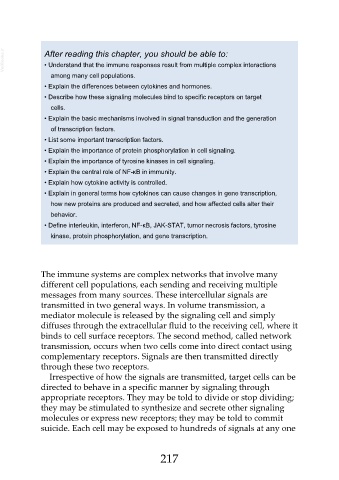Page 217 - Veterinary Immunology, 10th Edition
P. 217
VetBooks.ir After reading this chapter, you should be able to:
• Understand that the immune responses result from multiple complex interactions
among many cell populations.
• Explain the differences between cytokines and hormones.
• Describe how these signaling molecules bind to specific receptors on target
cells.
• Explain the basic mechanisms involved in signal transduction and the generation
of transcription factors.
• List some important transcription factors.
• Explain the importance of protein phosphorylation in cell signaling.
• Explain the importance of tyrosine kinases in cell signaling.
• Explain the central role of NF-κB in immunity.
• Explain how cytokine activity is controlled.
• Explain in general terms how cytokines can cause changes in gene transcription,
how new proteins are produced and secreted, and how affected cells alter their
behavior.
• Define interleukin, interferon, NF-κB, JAK-STAT, tumor necrosis factors, tyrosine
kinase, protein phosphorylation, and gene transcription.
The immune systems are complex networks that involve many
different cell populations, each sending and receiving multiple
messages from many sources. These intercellular signals are
transmitted in two general ways. In volume transmission, a
mediator molecule is released by the signaling cell and simply
diffuses through the extracellular fluid to the receiving cell, where it
binds to cell surface receptors. The second method, called network
transmission, occurs when two cells come into direct contact using
complementary receptors. Signals are then transmitted directly
through these two receptors.
Irrespective of how the signals are transmitted, target cells can be
directed to behave in a specific manner by signaling through
appropriate receptors. They may be told to divide or stop dividing;
they may be stimulated to synthesize and secrete other signaling
molecules or express new receptors; they may be told to commit
suicide. Each cell may be exposed to hundreds of signals at any one
217

